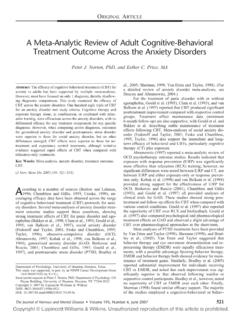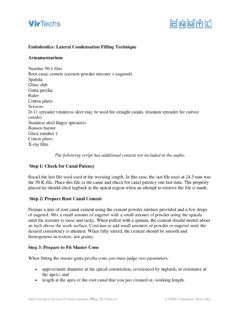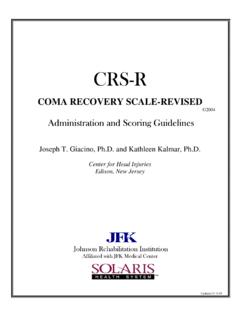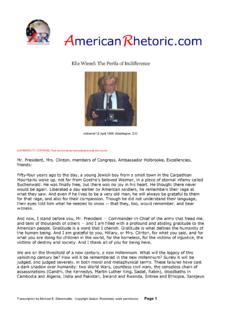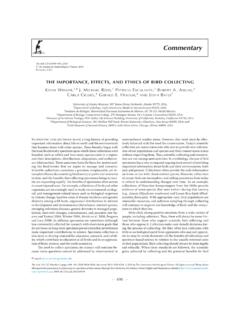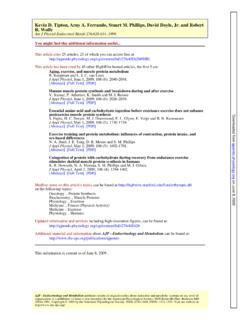Transcription of COGNITIVE THERAPY SCALE - REVISED (CTS-R)
1 Student code .. Score .. COGNITIVE THERAPY SCALE - REVISED (CTS-R) Blackburn, James, Milne & Reichelt Collaborators: , C. Baker, Standart & A. Claydon Newcastle upon Tyne, UK - August 2000 Page 1 THE REVISED COGNTIVE THERAPY SCALE AUGUST 2000 Scorer:.. Date:.. COGNITIVE THERAPY SCALE - REVISED (CTS-R) The rating of the SCALE The present seven point SCALE ( a 0-6 Likert SCALE ) extends from (0) where the therapist did not adhere to that aspect of THERAPY (non-adherence) to (6) where there is adherence and very high skill. Thus the SCALE assesses both adherence to THERAPY method and skill of the therapist. To aid with the rating of items of the SCALE , an outline of the key features of each item is provided at the top of each section. A description of the various rating criteria is given in the right hand margin - see example below in Figure 1.
2 Further details are provided in the accompanying manual. The examples are intended to be used as useful guidelines only. They are not meant to be used as prescriptive scoring criteria, rather providing both illustrative anchor points and guides. Adjusting the SCALE in the presence of patient difficulties The SCALE 's dimensions were devised for patients assessed as being well/moderately suited for COGNITIVE THERAPY (Safran & Segal, 1990). As such, adjustments may need to be made when patient difficulties are evident ( excessive avoidance). Indeed, with problematic patients it is sometimes difficult to apply CT methods successfully; that is, with desirable change. In such circumstances the rater needs to assess the therapist's therapeutic skills in the application of the methods. Thus even though the therapist may be unsuccessful at promoting change, credit should be given for demonstrations of appropriate skilful THERAPY .
3 Safran, & Segal, (1990) Interpersonal processes in COGNITIVE THERAPY . New York, Basic Books. Figure 1: Example of the scoring layout Key features: this is an operationalised description of the item (see examples within the CTS-R). Mark with an 'X' on the vertical line, using whole and half numbers, the level to which you think the therapist has fulfilled the core function. The descriptive features on the right are designed to guide your decision. When rating, take into consideration the appropriateness of therapeutic interventions for stage of THERAPY and perceived patient difficulty. Page 2 THE REVISED COGNTIVE THERAPY SCALE AUGUST 2000 Competence level_____Examples_____ 0 absence of feature, or highly inappropriate performance Incompetent Novice Advanced beginner Competent Proficient Expert 1 inappropriate performance, with major problems evident 2 evidence of competence, but numerous problems and lack of consistency 3 competent, but some problems and/or inconsistencies 4 good features, but minor problems and/or inconsistencies 5 very good features, minimal problems and/or inconsistencies 6 excellent performance, even in the face of patient difficulties * The present SCALE has incorporated the Dreyfus system (Dreyfus, 1989) for denoting competence, which is described fully in the manual.
4 Please note that the 'top marks ( near the 'expert' end of the continuum) are reserved for those therapists demonstrating highly effective skills, particularly in the face of difficulties ( highly aggressive or avoidant patients; high levels of emotional discharge from the patients; and various situational factors). The `Key Features' describe the important features that need to be considered when scoring each item. When rating the item, you must first identify whether some of the features are present. You must then consider whether the therapist should be regarded as competent with the features. If the therapist includes most of the key features and uses them appropriately ( misses few relevant opportunities to use them), the therapist should be rated very highly. The `Examples' are only guidelines and should not be regarded as absolute rating criteria. Scoring Distribution It is important to remember that the scoring profile for this SCALE should approximate to a normal distribution ( mid-point 3), with relatively few therapists scoring at the extremes.
5 Dreyfus, H. L. (1989). The Dreyfus model of skill acquisition. In J. Burke (ed.) Competency based education and training. London: Falmer Press. Page 3 THE REVISED COGNTIVE THERAPY SCALE AUGUST 2000 ITEM 1 - AGENDA SETTING & ADHERENCE Key features: To address adequately topics that have been agreed and set in an appropriate way. This involves the setting of discrete and realistic targets The format for setting the agenda may vary according to the stage of THERAPY - see manual. Three features need to be considered when scoring this item: (i) presence/absence of an agenda which is explicit, agreed and prioritised, and feasible in the time available; (ii) appropriateness of the contents of the agenda (to stage of THERAPY , current concerns etc.), a standing item being a review of the homework set previously; (iii) appropriate adherence to the agenda. Mark with an 'X' on the vertical line, the level to which you think the therapist has fulfilled the core function.
6 The descriptive features on the right are designed to guide your decision. NB: Agenda setting requires collaboration and credit for this should be given here, and here alone. Collaboration occurring at any other phase of the session should be scored under Item 3 (Collaboration). Competence Examples level NB: Score according to features, not examples! No agenda set, highly inappropriate agenda set, or agenda not adhered to. Inappropriate agenda set ( lack of focus, unrealistic, no account of patient's presentation, homework not reviewed). An attempt at an agenda made, but major difficulties evident ( unilaterally set). Poor adherence. Appropriate agenda, which was set well, but some difficulties evident ( poor collaboration). Some adherence. Appropriate agenda, minor difficulties evident ( no prioritisation), but appropriate features covered ( review of homework).
7 Moderate adherence. Appropriate agenda set with discrete and prioritised targets - review at the end. Agenda adhered to. Minimal problems. Excellent agenda set, or highly effective agenda set in the face of difficulties. 0 1 2 3 4 5 6 Page 4 THE REVISED COGNTIVE THERAPY SCALE AUGUST 2000 ITEM 2 - FEEDBACK Key features: The patient's and therapist's understanding of key issues should be helped through the use of two-way feedback: The two major forms of feeding back information are through general summary and chunking of important units of information. The use of appropriate feedback helps both the therapist to understand the patient's situation, and the patient to synthesise material enabling him/her to gain major insight and make therapeutic shifts. It also helps to keep the patient focused. Three features need to be considered when scoring this item: (i) presence and frequency, or absence, of feedback.
8 Feedback should be given/elicited throughout the THERAPY - with major summaries both at the beginning (review of week) and end (session summary), while topic reviews ( chunking) should occur throughout the session; (ii) appropriateness of the contents of the feedback; (iii) manner of its delivery and elicitation (NB: can be written). Competence Examples level NB: Score according to features, not examples! Absence of feedback or highly inappropriate feedback. Minimal appropriate feedback (verbal and/or written). Appropriate feedback, but not given frequently enough by therapist, with insufficient attempts to elicit and give feedback, feedback too vague to provide opportunities for understanding and change. Appropriate feedback given and elicited frequently, although some difficulties evident in terms of content or method of delivery.
9 Appropriate feedback given and elicited frequently, facilitating moderate therapeutic gains. Minor problems evident (eg. inconsistent). Highly appropriate feedback given and elicited regularly, facilitating shared understanding and enabling significant therapeutic gains. Minimal problems. Excellent use of feedback, or highly effective feedback given and elicited regularly in the face of difficulties. 0 1 2 3 4 5 6 THE REVISED COGNTIVE THERAPY SCALE AUGUST 2000 ITEM 3 - COLLABORATION Key features: The patient should be encouraged to be active in the session. There must be clear evidence of productive teamwork, with the therapist skillfully encouraging the patient to participate fully ( through questioning techniques, shared problem solving and decision making) and take responsibility. However, the therapist must not allow the patient to ramble in an unstructured way.
10 Three features need to be considered: the therapist style should encourage effective teamwork through his/her use of: (i) verbal skills ( non-hectoring); (ii) non-verbal skills ( attention and use of joint activities); (iii) sharing of written summaries. NB: Questioning is a central feature with regard to this item, but questions designed to facilitate reflections and self discovery should be scored under Item 9 (Guided Discovery). Competence Examples level NB: Score according to features, not examples! Patient is actively prevented or discouraged from being collaborative. The therapist is too controlling, dominating, or passive. Some occasional attempt at collaboration, but didactic style or passivity of therapist encourages passivity or other problems in the therapeutic relationship. Teamwork evident, but some problems with collaborative set ( not enough time allowed for the patient to reflect and participate actively).
